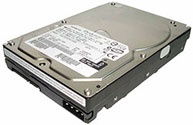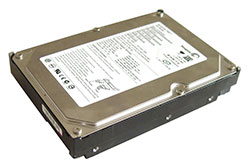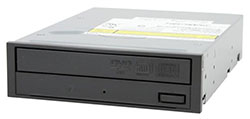Buyer's Guide: Mid-Range to High-End, May 2005
by Jarred Walton on May 23, 2005 5:30 PM EST- Posted in
- Guides
Storage Recommendations
There hasn't been a whole lot of change in the storage segment in terms of new products. Prices have dropped, but the recommendations overall remain about the same. Our recent Price Guide covered the storage market in more detail, and we'll refer interested readers there. The basic summary is that the HDD scene has not changed too much, and the DVDR scene has changed even less. The good news is that it means it's less difficult to pick a good product, which is especially true of DVDRs. The bad news is that I/O intensive tasks will still be waiting on the drives as much as ever.A topic that also deserves mention in regards to hard drives is RAID (Redundant Array of Inexpensive Disks). RAID can allow for either increased transfer rates, improved reliability, or both. RAID 0 provides increased performance by reading and writing to multiple drives at the same time in a process called striping, effectively doubling the sustained transfer rate for two drives. The problem is that if any drive in a RAID 0 configuration fails, you lose all the data. That's definitely not something to take lightly. RAID 1 goes the other route and provides a 1 for 1 copy of everything written to the hard drives, a.k.a. mirroring. In the event of a drive failure, the faulty drive is deactivated and you run with one drive until a replacement can be found. The drawback is that you now pay twice as much per GB of available storage. RAID 1+0 (sometimes called RAID 10) combines both striping and mirroring, but it requires at least four drives for the standard setup and you still only get half the realizable storage. RAID 5 is the most common remaining option, requiring a minimum of three drives to function. Only one of the drives in the array becomes "lost" capacity, but you need a good (re: expensive) controller to get acceptable RAID 5 performance. We don't really feel that RAID is something most people need, and a good backup strategy - to CDs or DVDs, usually - is often just as important as redundancy. Still, the option is there for those who need it.
Mid-Range HDD Recommendation
Hard Drive: Seagate 250GB 7200.8 SATA
Price: $128 Shipped
Picking a good hard drive for the Mid-Range market is relatively easy. You want a low cost per GB, and for the most part, the different brands all perform at close to the same level. Provided that you get a hard drive that has Fluid Dynamic Bearings (FDB), you shouldn't have to worry about any high pitched whine emanating from your computer. (This was a problem in the past, particularly with Western Digital and Maxtor drives.) Unless you're trying to build a truly silent PC, the amount of noise generated by the heads moving around will normally be drowned out by the noise of the GPU, CPU, and case fans - even the noisiest of drives is difficult to hear when confined within an ATX case. Just to make this clear, we mean that seek noise is difficult to hear, not bearing noise; we have numerous older drives that emit a high-pitched whine that can be heard a couple of rooms away.
Our recommendation goes to the Seagate model for several reasons. Besides being spacious and quiet, it provides NCQ support and a 5-year warranty, all at a price that's just as low as any of the competition. If you are for some reason opposed to 250GB hard drives, you can find everything from 80GB to 200GB at a lower price than the Seagate 250GB (depending on model and brand). The smaller drives end up coming with a higher cost per GB, however, to the point where anything less than 80GB isn't worth considering. $60 for an 80GB drive is still a reasonable deal, but you can double the capacity for only a 50% price increase. Other than Seagate, we like Samsung drives due to their even lower noise levels. Hitachi, Maxtor, and Western Digital are all decent as well, but we would suggest that you make sure you get FDB with the Maxtor and WD drives. SATA-2 drives are also starting to show up at retail, and while they may not offer a performance advantage, the price difference is negligible. Hitachi is the only manufacturer currently showing up in our Pricing Engine, although that will change with time.
 |
 |
 |
| Click images to enlarge. | ||
High-End HDD Recommendations
Hard Drive: Western Digital Raptor 74GB 10,000RPM SATA
Price: $180 Shipped
Hard Drive: Maxtor DiamondMax 10 250GB 16MB SATA
Price: $160 Shipped
Hard Drive: Hitachi 7K250 400GB SATA
Price: $265 Shipped
There are three areas that we consider to be high end for hard drives. First is the option for a faster spindle speed, leading to faster transfer rates and access times. 10,000RPM SATA and SCSI drives are available, but the SATA drives are cheaper and don't require an additional SCSI controller. You can even go for a 15,000RPM SCSI drive, although the cost is twice as much (or more) as that of the 10,000RPM drives of the same capacity. The next item that makes a hard drive high end is additional cache, and at present, the only manufacturer to fill that niche is Maxtor, with both its SATA and PATA MaxLine III/DiamondMax 10 models including 16MB of cache rather than 8MB. The final item that can make a high end drive is increased capacity, with 300 to 400 GB drives now available. Increased capacity via higher data densities also improves the transfer rate of a drive, although it doesn't help the access times. Determining which of these features are the most important along with keeping price in check is difficult. Sure, you can get 146GB 15,000RPM SCSI drives to satisfy the need for performance and capacity, but at a cost of over $1000 per drive, they're not meant for mere mortals.
In the end, we can't really give one specific recommendation for a high end drive. If you need capacity above all else, the Hitachi 7K250 400GB will fit the bill. Seagate also offers a 400GB 7200.8 drive for about $25 more if you're interested. Striking a middle ground between performance and capacity is the Maxtor DiamondMax 10 line, of which we've selected the 250GB model. The 300GB model has a similar cost per GB, so if you want a bit more capacity, that's definitely an option. While we don't care too much for the old IDE interface, we should also note that the Maxtor drives are available in PATA format for quite a bit less. Finally, if you're only interested in having the highest possible sustained transfer rate and access times, the Western Digital Raptor 74GB gets our recommendation again. 15,000RPM SCSI drives would be even faster than the Raptor, but they start at around $400 for the Hitachi 15K73 and go up from there - twice as much as the Raptor, not counting the cost of SCSI controllers and cables.
Optical Recommendation
DVD+R Drive: NEC 16X 3520A
Price: $48 Shipped
With 16X burn speeds for both DVD+R and DVD-R media and 8X/6X for the respective RW variants, the only thing really missing from the NEC 3520A is DVD-RAM support. If you need or want that, the LG GSA-4163B has 5X DVD-RAM support for just a few dollars more. Either drive will work well for most people, and while some will argue that Plextor or Sony drives are better, we haven't been able to back up such claims with any tests. Given the higher price - over twice as much in the case of the Plextor 16X - we cannot justify such a purchase. Pioneer's DVR-109 is another alternative, and Lite-On, Toshiba, and BenQ are also worth considering, assuming that the price is right. We feel that features and performance are all now close enough that we'd simply take the cheapest 16X DVDR Dual-Layer capable drive and be done with it, which is why the NEC and LG get our recommendation. As always, match the color of the drive with your case if that's important to you.
Floppy Recommendation
Floppy: Any
Price: $8 Shipped
When you're spending this much money on a nice, new system, it's almost a shame to have to put in old technology like a floppy drive. While not strictly required, we'd rather have the drive installed and never use it than to not have it and discover later that we need it. Anyone planning on using RAID will definitely want a floppy drive, as it's required for installing XP onto any RAID setup that we're aware of. Windows Longhorn should finally kill off the floppy requirement, but that's still more than a year off. $8 over 365 days amounts to just 2.2 cents per day - you can manage it, right? As with the DVDR drive, you will probably want to match the floppy to the case.












60 Comments
View All Comments
ProviaFan - Monday, May 23, 2005 - link
And I had an Epox board (8RDA, which was all the rage when it came out) die just over a year old from bad capacitors. Now, I use an Abit NF7-S v2, but found the guide useful as I'm planning an upgrade "soon" (dual core is necessary as I'm a non-gaming multitasker: Photoshop, Illustrator, Indesign - at the same time, and SMP is well beyond the budget).Thanks Jarred, I appreciated the article, despite the few typos and the whiner(s) in the comment section. :)
arswihart - Monday, May 23, 2005 - link
I think Epox is more than a step above Biostar and Soltek, as for customer support, Epox is lightyears better than Asus and MSI, so not sure what you are referring to there. They also have the best BIOS support I've ever seen, always updated quickly and often, so again I don't know where you are getting your information.kevindarcy - Monday, May 23, 2005 - link
For those of us who run our PCs continuously, I think Anandtech should be giving a clear recommendation of Venice over Newcastle, regardless of their respective overclocking potentials, or support of SSE3. According to PC Perspective (http://www.pcper.com/article.php?aid=127&type=... a Venice CPU consumes 20W less than an equivalent Newcastle at idle, and 37W less under load (!). Where I live, the electricity savings alone, based on the "idle" number, are at least $16/yr, more than enough to justify the (hopefully temporary) price differential, not to mention the "intangible" benefits of having a quieter, cooler-running computer.JarredWalton - Monday, May 23, 2005 - link
15 - typo. Fixed now.1 - Would you buy a LAN card for a PC? Most people would say no, and I feel about the same for audio. If you find the integrated audio is lacking, it's simple enough to add a sound card after the fact.
whatever - Monday, May 23, 2005 - link
quote:That means Intel's 845 and 855 chipsets or the aforementioned nForce 4 SLI for 775.
Isn't 845 and 855 old? don't they mean 945 and 955? (this is from the Intel mobos section)
KristopherKubicki - Monday, May 23, 2005 - link
>and I even wonder sometimes if your site is getting some compensation for these recommendations.arswihart: Generally we will always recommend at Tier 1 motherboard manufacturer over a Tier 2 one. The peripheral things like product support, updates and MTBF usually sway our opinion in favor of an ASUS/MSI/Gigabyte board over a Biostar/Epox/Soltek board even if they are nearly the same. By the way, Epox's production was actually via another Tier 1 production house until not too long ago.
Kristopher
JarredWalton - Monday, May 23, 2005 - link
*I'm* not in the market for an SLI rig. Very few people really are. My 6800GT is more than powerful enough for what I do, and I think most people feel the same way.The reason I went with SLI for the High-End is because I feel people that are interested in spending $500+ on a CPU are probably going to be interested in the bragging rights of SLI. I think the Mid-Range is the sweet spot for computer purchases, so I really look at the High-End market as potential upgrades rather than entire systems. Of course, if you win the lottery or something, go for it! :)
arswihart - Monday, May 23, 2005 - link
i only say that because the products I refer to have been available for many many months, except for the 9npa sli. It is nonsense that you haven't been aware of their existence until today.arswihart - Monday, May 23, 2005 - link
you mean you miss all of them, not just some of themJarredWalton - Monday, May 23, 2005 - link
I've been going by the AnandTech Pricing Engine (which is apparently missing the EPoX and Biostar SLI products). I generally search around at Newegg, ZipZoomFly, ChiefValue, Monarch, and several other sites to verify that I've got the best prices I can find as well as most recent product lists, but obviously I miss some of them. Sorry.As for the EPoX nF4 Ultra vs. Chaintech, I wouldn't say the EPoX board is bad (though I haven't tested it), but past experience is that it's probably not much better than other options. We'll be coming out with a new nF4 motherboard roundup, so I'll have to see what our other editors say about the various models. :)
(I did mention nF3, by the way - at the top of the page. I would't recommend it for a complete new system, but for upgraders it's still a reasonable choice.)